The Production and Quality of Different Varieties of Papaya Grown under Greenhouse in Short Cycle in Continental Europe
Abstract
1. Introduction
2. Materials and Methods
2.1. Experimental Greenhouse and Equipment
2.2. Climatic Conditions
2.3. Experimental Procedures
2.4. Fertigation
2.5. Field Layout and Plant Material
- T0: Intenzza.
- T1: Hermaphrodite Intenzza onto female Intenzza.
- T2: Sweet Sense.
- T3: Vitale.
- T4: Caballero.
- T5: Alicia.
2.6. Indices Maturity Stage for Harvesting
2.7. Data Collection and Statistical Analysis
3. Results
3.1. Foliar Analysis
3.2. Crop Protection
3.3. Total Yield
3.4. Average Fruit Weight (AFW)
3.5. Number of Fruits Per Plant
3.6. Total Soluble Solids
3.7. Height from the Soil and Node in which the First Flower Appears
3.8. Perimeter of the Stem
4. Discussion
5. Conclusions
Author Contributions
Funding
Acknowledgments
Conflicts of Interest
References
- FAO. Crop Data; Food and Agriculture Organization of the United Nations (FAO): Roma, Italy, 2017; Available online: http://www.fao.org/faostat/en/#data/QC (accessed on 12 April 2019).
- Karunamoorthi, K.; Hyung-Min, K.; Jegajeevanram, K.; Xavier, J.; Vijayalakshmi, J. Papaya: A gifted nutraceutical plant—A critical review of recent human health research. Tang Humanit. Med. 2014, 4, 21–217. [Google Scholar] [CrossRef][Green Version]
- Hueso, J.J.; Schmildt, R.; Schmildt, O.; Cuevas, J. Comparación de los Sistemas Productivos de la Papaya en España y Brasil. Innovagri. 2017. Available online: https://www.innovagri.es/investigacion-desarrollo-inovacion/comparacion-de-los-sistemas-productivos-de-la-papaya-en-espana-y-brasil.html (accessed on 29 March 2019).
- Hueso, J.J.; Salinas, I.; Pinillos, V.; Cuevas, J. El Cultivo de la Papaya en el Sureste de España. Horticultura—Interempresas. 2017. Available online: http://www.interempresas.net/Horticola/Articulos/196398-El-cultivo-de-la-papaya-en-el-Sureste-de-Espana.html (accessed on 29 March 2019).
- Salinas, I.; Hueso, J.J.; Cuevas, J. Fruit growth model, thermal requirements and fruit size determinants in papaya cultivars grown under subtropical conditions. Sci. Hortic. 2019, 246, 1022–1027. [Google Scholar] [CrossRef]
- FAO. Norma para la Papaya. CODEX STAN 183-1993. Food and Agriculture Organization of the United Nations (FAO). CODEX Alimentarius. International Food Standars. 2011. Available online: http://www.fao.org/fao-who-codexalimentarius/sh-proxy/es/?lnk=1&url=https%253A%252F%252Fworkspace.fao.org%252Fsites%252Fcodex%252FStandards%252FCODEX%2BSTAN%2B183-1993%252FCXS_183s.pdf (accessed on 16 January 2019).
- Santamaría-Basulto, F.; Díaz-Plaza, R.; Sauri-Duch, E.; Espadas y Gil, F.; Santamaría-Fernández, J.M.; Larqué-Saavedra, A. Quality characteristics in maradol papaya fruits at the comsumption ripeness stage. Agric. Téc. Méx. 2009, 35, 347–353. [Google Scholar]
- Nantawan, U.; Kanchana-udomkan, C.; Drew, R.; Ford, R. Identification of genes related to sugar content in Carica papaya L.: Differential expression and candidate marker development. Acta Hortic. 2018, 1203, 129–136. [Google Scholar] [CrossRef]
- Miguel Gómez, A. El injerto de plantas de tomate. Serie documentos de la editorial THM. 2011. 35p. Available online: https://issuu.com/horticulturaposcosecha/docs/el_injerto_de_plantas_de_tomate?e=8490508/66927659 (accessed on 1 April 2019).
- Valera, D.L.; Belmonte, L.J.; Molina-Aiz, F.D.; López, A.; Camacho, F. The greenhouses of Almería, Spain: Technological analysis and profitability. Acta Hortic. 2017, 1170, 219–226. [Google Scholar] [CrossRef]
- Valera-Martínez, D.L.; Belmonte-Ureña, L.J.; Molina-Aiz, F.D.; López-Martínez, A. Greenhouseagriculture in Almería. A Comprehensive Techno-Economicanalysis; Cajamar Caja Rural: Almería, Spain, 2016; 504p, ISBN 978-84-955531-75-9. Available online: https://www.publicacionescajamar.es/pdf/series-tematicas/economia/greenhouse-agriculture-in-almeria.pdf (accessed on 3 April 2019).
- Camacho-Ferre, F.; Fernández-Rodríguez, E.J. El Cultivo de Sandía Apirena Injertada, bajo Invernadero, en el Litoral Mediterráneo Español; Ed. Caja Rural de Almería: Almeria, Spain, 2000; pp. 32–35. ISBN 84-922785-9-5. Available online: https://www.publicacionescajamar.es/pdf/series-tematicas/agricultura/el-cultivo-de-sandia-apirena-injertada.pdf (accessed on 3 April 2019).
- Semillas del Caribe. Ficha técnica de la semilla de papaya Intenzza. 2015. 2p. Available online: http://www.semillasdelcaribe.com.mx/wp-content/uploads/2015/10/FichaTecnicaIntenzza.pdf (accessed on 15 January 2019).
- Semillas del Caribe. Ficha técnica de la semilla de papaya Sweet Sense. 2015. 2p. Available online: http://www.semillasdelcaribe.com.mx/wp-content/uploads/2015/10/FichaTecnicaSweetSense.pdf (accessed on 15 January 2019).
- Capgenseeds Datos Técnicos sobre la papaya Caballero. 2016. Available online: http://www.capgenseeds.com/es/venta-semillas/comprar-semillas-papayas/papaya caballero (accessed on 16 January 2019).
- Capgenseeds. Datos Técnicos sobre la Papaya Alicia. 2016. Available online: http://www.capgenseeds.com/es/venta-semillas/comprar-semillas-papayas/papaya-alicia (accessed on 16 January 2019).
- Osuna-Enciso, T.; Escobar-Álvarez, J.L.; Nolasco-González, Y.; Muy-Rangel, M.D.; Rubio-Carrasco, W.; Contreras-Martínez, R.; Becerra-Leor, E.N.; Obando-Cruz, M.E. Proyecto 60135: El manejo integral del cultivo de Papaya en México, un Acercamiento innovador. Estado nutricional y calidad del fruto de papaya en Veracruz, Oaxaca y Colima, México. 2015, p. 9. Available online: http://sistemanodalsinaloa.gob.mx/archivoscomprobatorios/_16_informetecnicoconsultorias/7615.pdf (accessed on 14 January 2019).
- Guzmán, G. Guía para el cultivo de la papaya (Carica papaya L.); Ministerio de Agricultura y Ganadería: San José de Costa Rica, Costa Rica, 1998; pp. 56–60. ISBN 9977-9921-4-2. Available online: http://www.mag.go.cr/bibliotecavirtual/F01-0658papaya.pdf (accessed on 21 January 2019).
- Jiménez, J.A. Manual práctico para el cultivo de la papaya Hawaiana; Editorial EARTH: Limón, Costa Rica, 2002; pp. 71–72. ISBN 9977-84-004-0. Available online: http://usi.earth.ac.cr/glas/sp/90022688.pdf (accessed on 21 January 2019).
- Escamilla, J.L.; Saucedo, C.; Martínez, M.T.; Martínez, A.; Sánchez, P.; Soto, M. Organic, Mineral and Foliar Fertilization on Development and Production of Papaya cv.Maradol. Terra Latinoam. 2003, 21, 157–166. [Google Scholar]
- Singh, D.K.; Ghosh, S.K.; Paul, P.K.; Suresh, C.P. Effect of Different Micronutrients on Growth, Yield and Quality of Papaya (Carica papaya L.) cv. Ranchi. Acta Hortic. 2010, 851, 351–356. [Google Scholar] [CrossRef]
- Bhalerao, P.P.; Patel, B.N.; Patil, S.J.; Gaikwad, S.S. Effect of foliar application of Ca, Zn, Fe and B on growth, yield and quality of papaya (Carica papaya) cv. Taiwan Red Lady. Curr. Hortic. 2014, 2, 35–39. [Google Scholar]
- Pérez-Hernández, E. Ensayo de variedades de papaya 2013–2015; Información Técnica; Cabildo de Tenerife: Santa Cruz de Tenerife, Spain, 2016; 12p, Available online: http://www.agrocabildo.org/publica/Publicaciones/subt_599_Var%20papaya%20web.pdf (accessed on 23 January 2019).
- Santamaría, F.; Mirafuentes, F.; Zavala, M.J.; Vázquez, E. Fruitquality of red papaya genotypescultivated in yucatan, Mexico. Agronomíacostarricense 2015, 39, 161–167. [Google Scholar]
- Sirithon, S.; Niwat, K. Quality, bioactive compounds and antioxidant capacity of selected climacteric fruits with relation to their maturity. Sci. Hortic. 2017, 221, 33–42. [Google Scholar] [CrossRef]
- Eskin, N.A.M.; Hoehn, E.; Shahidi, F. Fruits and vegetables. In Biochemistry of Foods; Eskin, N.A.M., Shahidi, F., Eds.; Academic Press: San Diego, CA, USA, 2013; pp. 49–126. [Google Scholar] [CrossRef]
- Alonso, M.; Tornet, Y.; Ramos, R.; Farrés, E.; Aranguren, M.; Rodríguez, D. Characterization and evaluation of two papaya hybrids in Cuba. Agric. Téc. Méx. 2008, 34, 333–339. [Google Scholar]
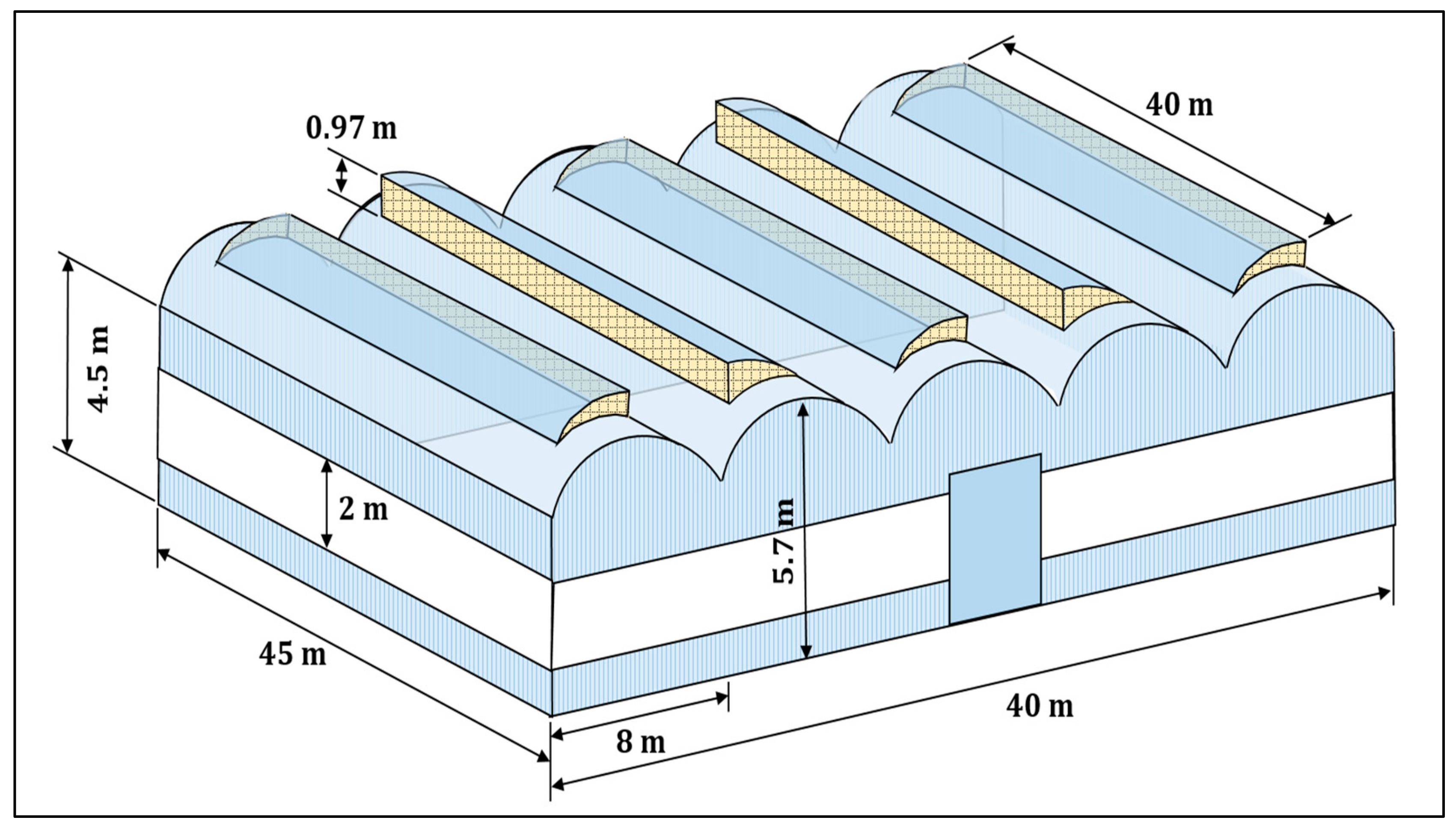
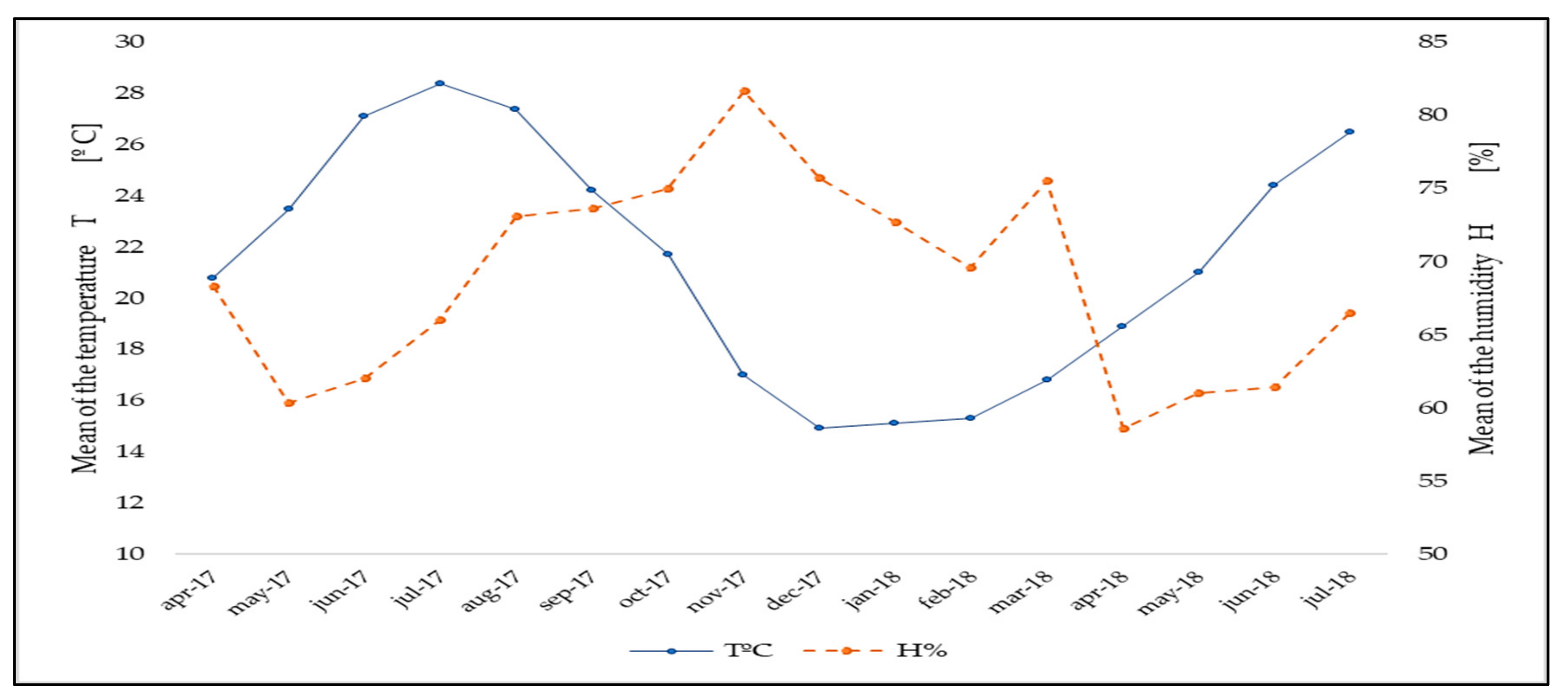
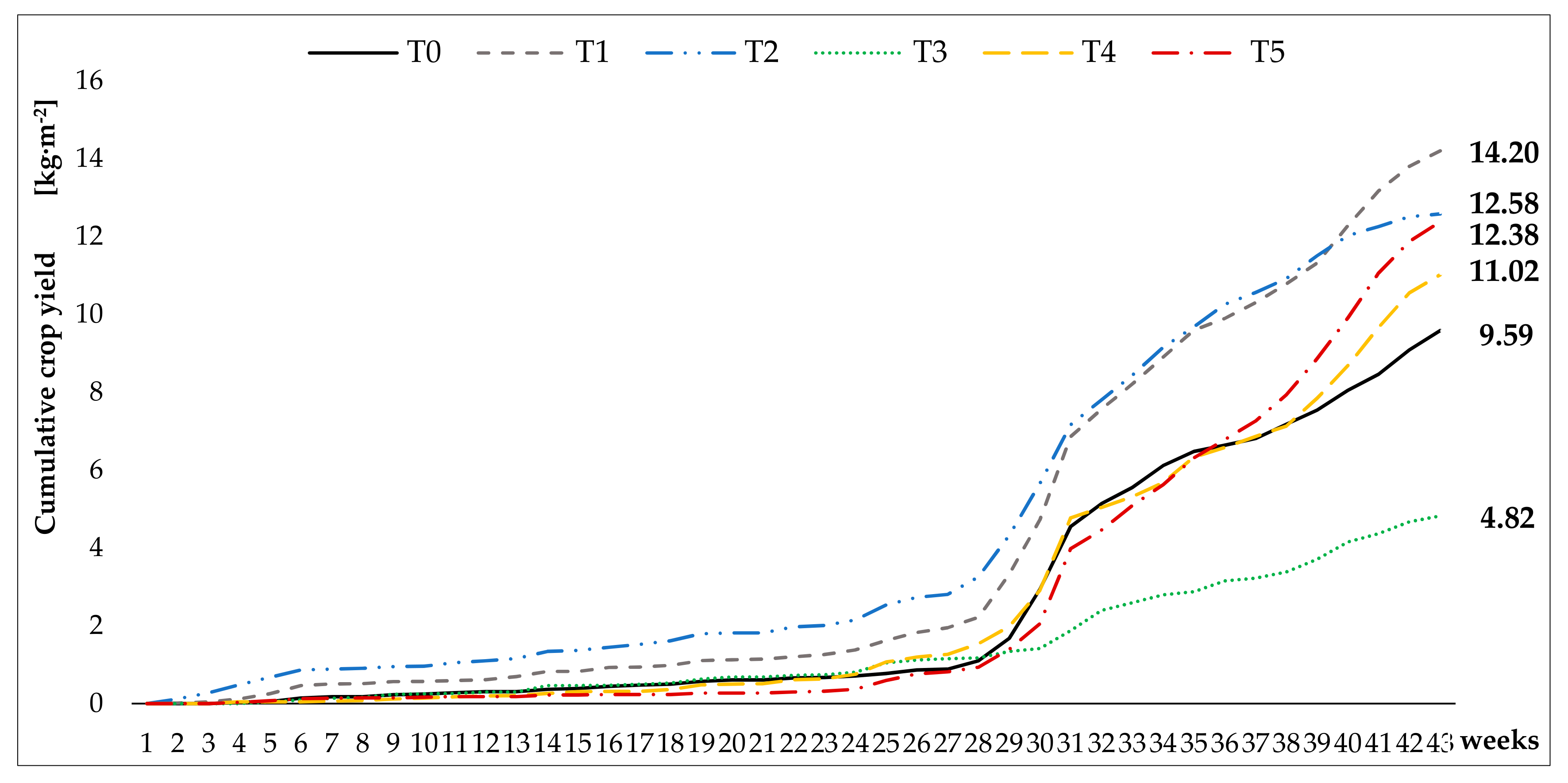
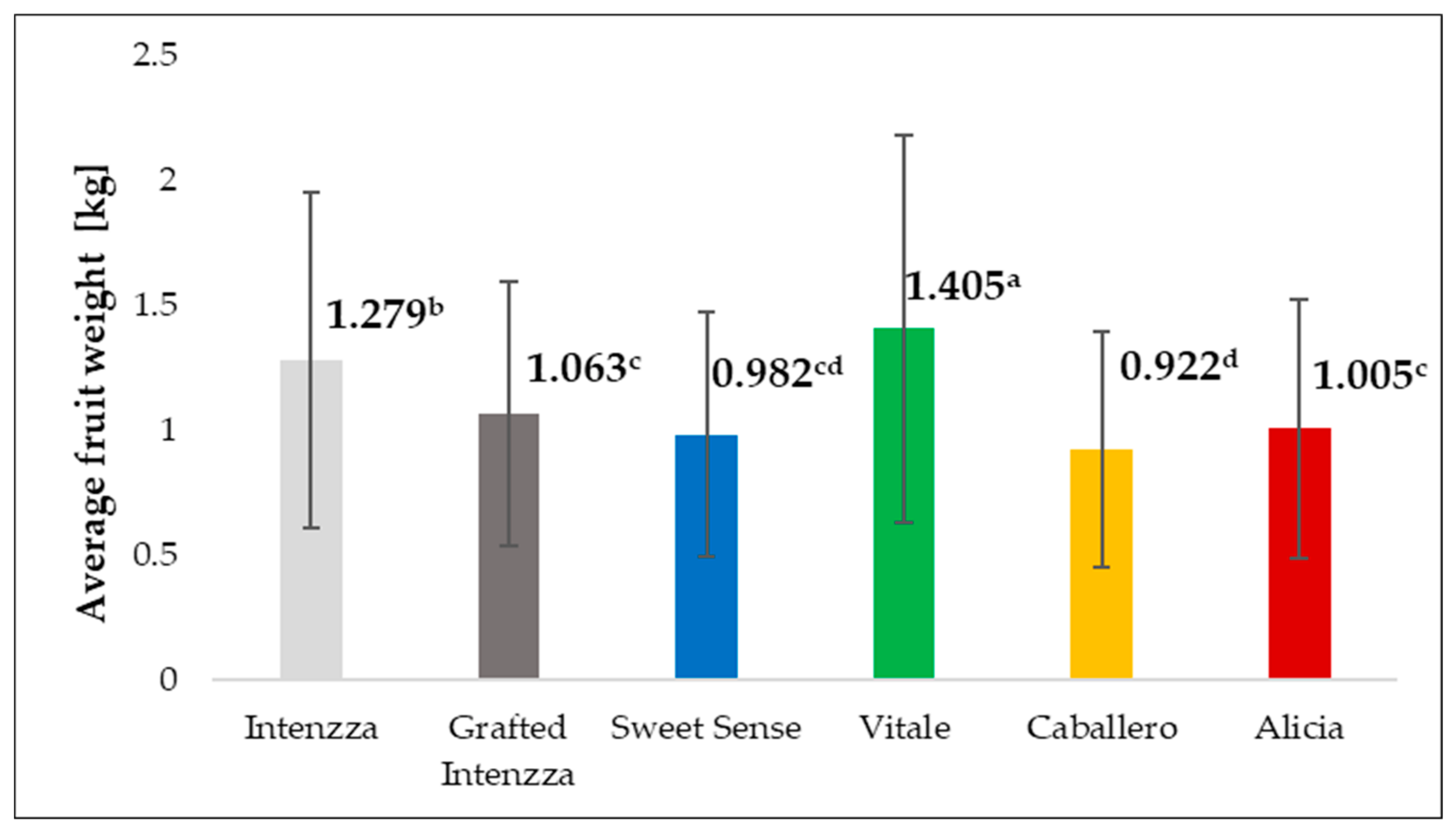
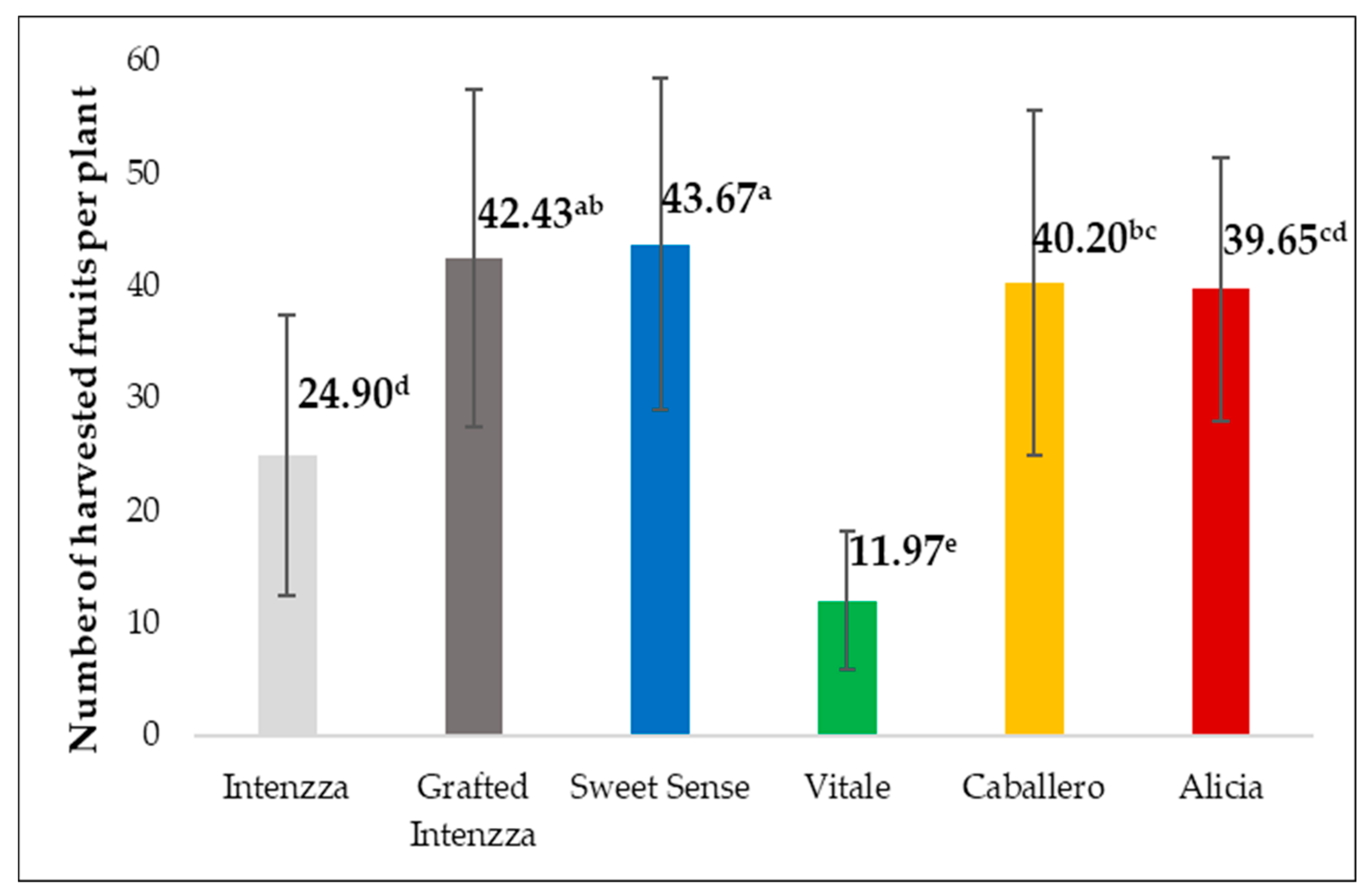
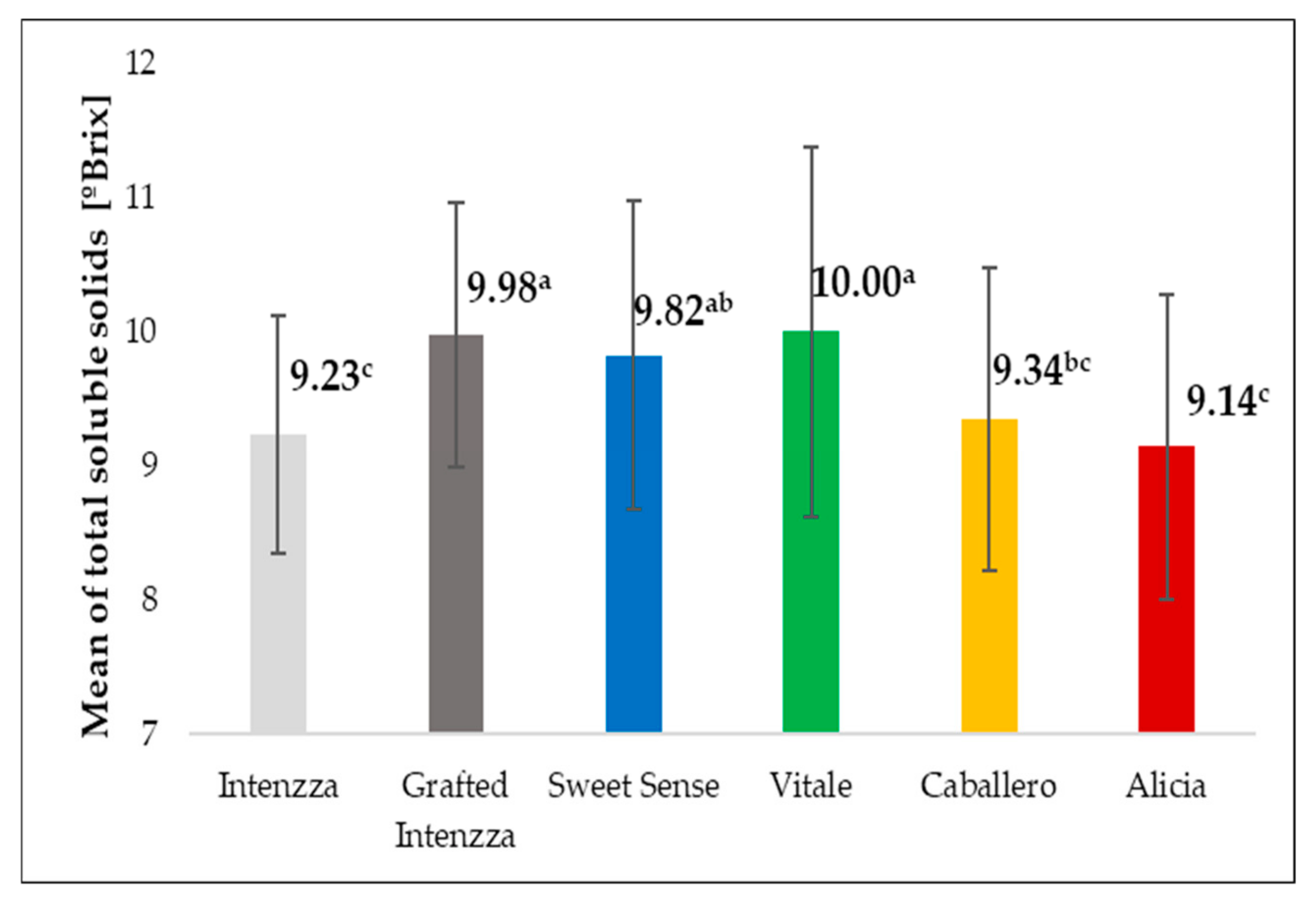
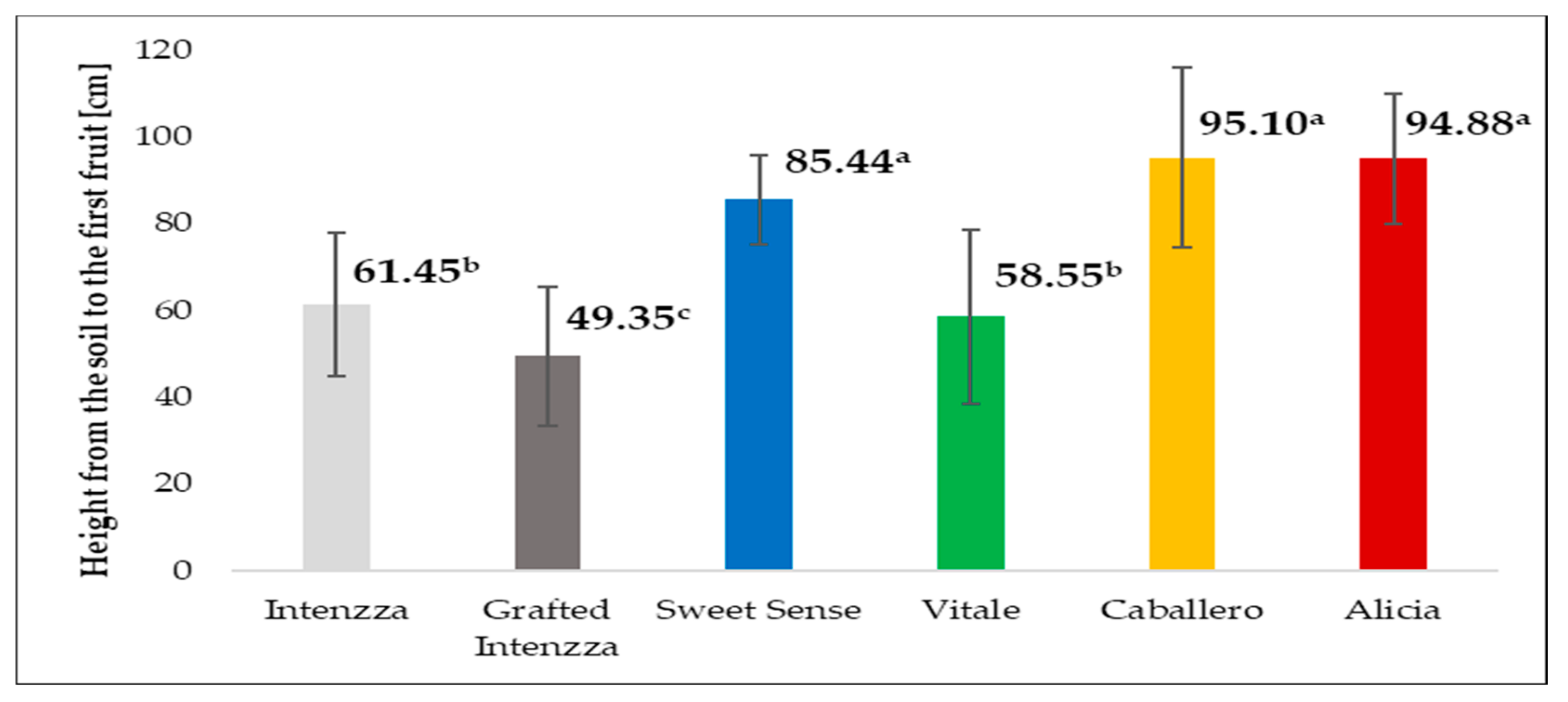
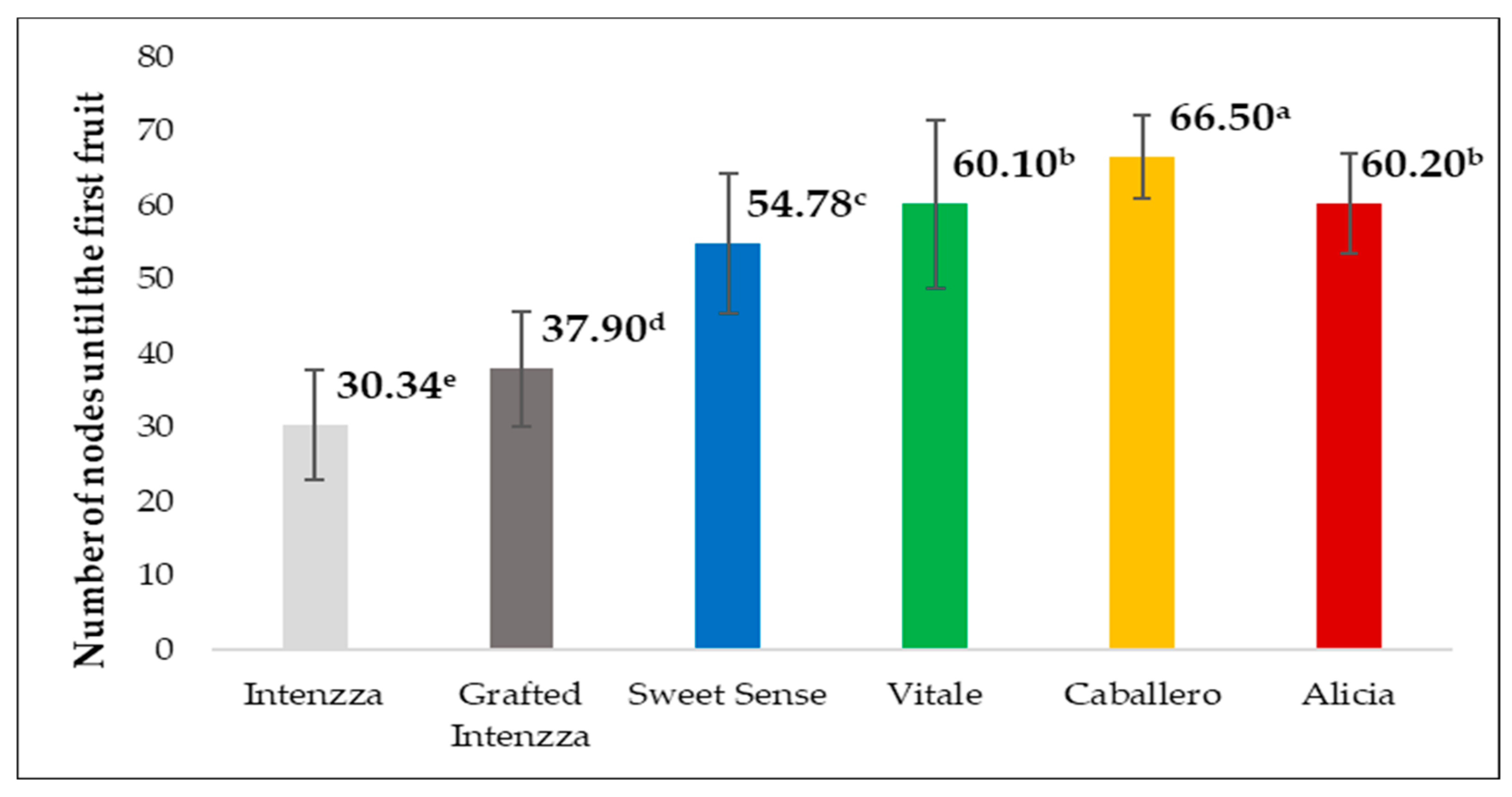
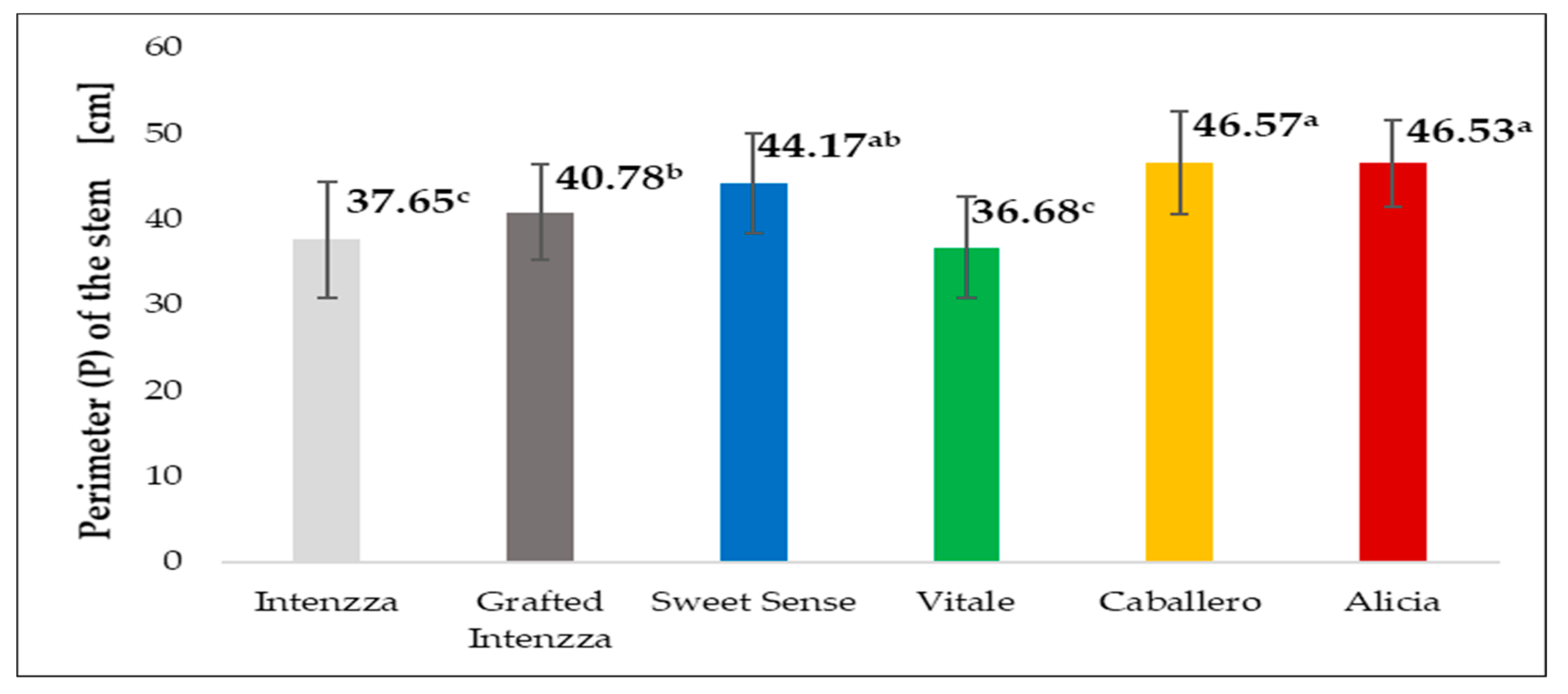
| Variety (Seller) [13,14,15,16] | Fruit Weight (g) | Size FAO * [6] | Main Characteristics | Sweetness Total Soluble Solids (° Brix) |
|---|---|---|---|---|
| Intenzza (Semillas del Caribe) | 1500–2200 | I, J | Developed for medium size or Formosa type papaya market. Its epidermis is orange-yellow when it is ripe, and its interior is red. | 10–13 |
| Sweet Sense (Semillas del Caribe) | 1200–1800 | H, I | When it is ready to be consumed, on its ideal ripening state, its epidermis is yellow, and its interior is salmon. It is classified as “baby” type. | 11–14 |
| Vitale (Vitalplant Nursery) | >1000 | G, H, I, J | It is a plant with medium vigor, very open. | Without information from the seller |
| Caballero (CapGenSeeds) | 650–900 | E, F, G | It is not a very big plant and it has few leaves. It is ideally grown under greenhouse. Its fruits are very sweet. | 14–15 |
| Alicia (CapGenSeeds) | 750–1100 | F, G | It is not a very high plant; therefore, it is ideal to grow under greenhouse. The internodes of the plant are very short. Alicia tolerates low temperatures. Fruit harvest can be carried out in an advance ripening stage. | Without information from the seller |
| Treatments | Intenzza | Grafted Intenzza | Sweet Sense | Vitale | Caballero | Alicia | p-Value |
|---|---|---|---|---|---|---|---|
| T0 | T1 | T2 | T3 | T4 | T5 | ||
| Yield (kg·m−2) | 9.59 c | 14.20 a | 12.58 ab | 4.82 d | 11.02 bc | 12.38 ab | 0.00 |
| SIZE (FAO) AFW (kg) | H 1.279 b | G 1.063 c | G 0.982 cd | H 1.405 a | G 0.922 d | G 1.005 c | 0.00 |
| Number of harvested fruits per plant | 24.90 d | 42.43 ab | 43.67 a | 11.97 e | 40.20 bc | 39.65 cd | 0.00 |
| TSS (° Brix) | 9.23 c | 9.98 a | 9.82 ab | 10.00 a | 9.34 bc | 9.14 c | 0.00 |
| MAX TSS (° Brix) | 9.72 bc | 10.45 a | 10.19 ab | 10.36 a | 9.72 bc | 9.50 c | 0.00 |
| MIN TSS (° Brix) | 8.76 c | 9.51 ab | 9.46 ab | 9.59 a | 9.01 bc | 8.77 c | 0.00 |
| Increase of TSS (° Brix) 1st to 4th measurement Average values | 10.1 a | 8.6 a | 10.3 a | 9.2 a | 9.1 a | 9.0 a | 0.99 |
| Increase of TSS (° Brix) 1st to 4th measurement Maximum values | 11.8 a | 11.9 a | 8.8 a | 9.7 a | 9.5 a | 10.3 a | 0.99 |
| Increase of TSS (° Brix) 1st to 4th measurement Minimum values | 8.1 a | 8.7 a | 11.1 a | 7.2 a | 8.6 a | 8.3 a | 0.99 |
| Height from the soil to the first fruit (cm) | 61.45 b | 49.35 c | 85.44 a | 58.55 b | 95.1 a | 94.88 a | 0.00 |
| Perimeter of the stem (cm) | 37.65 c | 40.78 b | 44.17 ab | 36.68 c | 46.57 a | 46.53 a | 0.00 |
| Diameter of the stem | 11.98 a | 12.98 b | 14.06 bc | 11.68 a | 14.82 c | 14.81 c | 0.00 |
| Number of nodes until the first fruit | 30.34 e | 37.90 d | 54.78 c | 60.10 b | 66.50 a | 60.20 b | 0.00 |
© 2019 by the authors. Licensee MDPI, Basel, Switzerland. This article is an open access article distributed under the terms and conditions of the Creative Commons Attribution (CC BY) license (http://creativecommons.org/licenses/by/4.0/).
Share and Cite
Honoré, M.N.; Belmonte-Ureña, L.J.; Navarro-Velasco, A.; Camacho-Ferre, F. The Production and Quality of Different Varieties of Papaya Grown under Greenhouse in Short Cycle in Continental Europe. Int. J. Environ. Res. Public Health 2019, 16, 1789. https://doi.org/10.3390/ijerph16101789
Honoré MN, Belmonte-Ureña LJ, Navarro-Velasco A, Camacho-Ferre F. The Production and Quality of Different Varieties of Papaya Grown under Greenhouse in Short Cycle in Continental Europe. International Journal of Environmental Research and Public Health. 2019; 16(10):1789. https://doi.org/10.3390/ijerph16101789
Chicago/Turabian StyleHonoré, Mireille N., Luis J. Belmonte-Ureña, Asensio Navarro-Velasco, and Francisco Camacho-Ferre. 2019. "The Production and Quality of Different Varieties of Papaya Grown under Greenhouse in Short Cycle in Continental Europe" International Journal of Environmental Research and Public Health 16, no. 10: 1789. https://doi.org/10.3390/ijerph16101789
APA StyleHonoré, M. N., Belmonte-Ureña, L. J., Navarro-Velasco, A., & Camacho-Ferre, F. (2019). The Production and Quality of Different Varieties of Papaya Grown under Greenhouse in Short Cycle in Continental Europe. International Journal of Environmental Research and Public Health, 16(10), 1789. https://doi.org/10.3390/ijerph16101789







